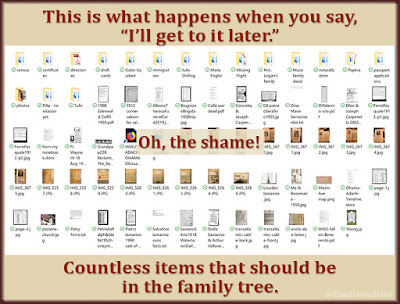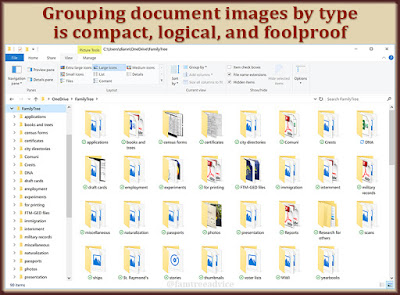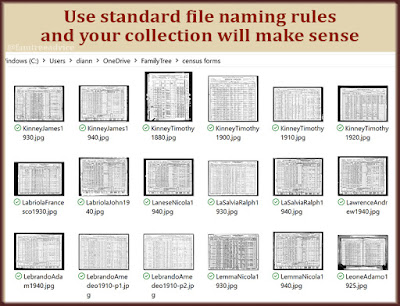I found them sitting there in the "family tree" folder on my computer. Eight Italian vital records and a couple of U.S. immigration records that did not belong there. It was clear I'd cropped the images and made them ready for my family tree. Then I must have dragged them into the wrong folder.
What else had I misfiled or left unfinished? My main family tree folder is where I keep things I plan to work on later. These files didn't belong there.
If you started your genealogy research journey a while ago, you know more now than you did then. You've made breakthroughs on some of your lines. You've discovered new resources along the way.
It's time to use your growing knowledge and resources to clean up past mysteries.
Give your old files and notes a fresh look with more experienced eyes. For instance, in my main folder are two files I purposely left there until I learned more. One is an 1893 ship manifest featuring the last name of my 2nd great grandmother: Consolazio. I labelled the file ConsolazioPaolina1893, but who was Paolina?
 |
| How many family tree mysteries can you solve now that you know more? |
Thanks to the vital records from the Consolazio hometown (Santa Paolina, Avellino, Italy), I now know she is my 2nd great grandmother's sister. This ship manifest gives me the names of two of her children and tells me they were bound for Orange, New Jersey.
Looking at that 1893 manifest, I recognize other Santa Paolina last names: Dato, Bruno, Morrone, Maiorano, Stanziale. The record doesn't include hometowns, but my research tells me who's from Santa Paolina. There are two Consolazio families on the manifest, and I'll bet I can work both into my family tree now.
Also in my main family tree folder is an 1886 church record sent to me by a friend. It's a marriage between two people with my two grandfathers' last names. It turns out he is my 3rd cousin 5 times removed and she is my 4th cousin 3 times removed.
Also in that catch-all folder is a list of people who died in the 1805 earthquake in my Grandpa's hometown. In the past, I've tried to place these people in my family tree. A handful were already there, but I had no idea they'd died in the earthquake. One is my sixth great aunt. In this text file I left myself a note saying "DOWN TO HERE," signaling where I should pick up and continue my search.
How many tasks like these have you left unfinished? How many notes and documents have you tucked away for later? How many have you completely forgotten about?
I use Family Tree Maker software to build my tree. There is a Tasks feature that lets you record what you need to do for a particular person. As more and more documents become available, it's important to revisit these tasks. See what you can do about them.
I also use the Bookmarks feature in Family Tree Maker. Whenever I add an important note to a person, a note I want to make sure I don't lose, I give them a bookmark. These bookmarks a visible in the index of all people, so they're easy to spot.
These notes are handy when I'm wondering why a person's trail has gone cold.
 |
| Make sure your "why I did this" notes are easy to find in your family tree. |
Dig Into Those Dusty Crevices
To give your family tree a spring cleaning, check your:
- Computer files. Do you see any files on your computer that are not where they belong? The files in my Family Tree folder belong in my immigration and certificates folders. I'll check my family tree to make sure these images are in there. Then I can file them away properly.
- Paper files. Many family tree researchers keep extensive paperwork in binders. (Not me.) Do you have a pile of papers somewhere, waiting for your attention? Divide and conquer!
- Notes. You may use a program like EverNote or a paper notebook to record your research notes. Can you solve any of those mysteries now?
- Family tree. Have you recorded notes and tasks in your family tree software? I'll bet you can solve some of them now. You may simply need to give them another look.
I've spent the past week filling in the holes in my family tree. It was surprising how many facts were only a search away. I found missing last names, missing birth and death dates, and missing marriages. It was so satisfying!
I know you'll feel a great sense of accomplishment when you tie up some of your loose ends. And along the way, you may figure out a better way to keep these notes so they don't get buried again. Find a method that works best for you, then stick to it!


















